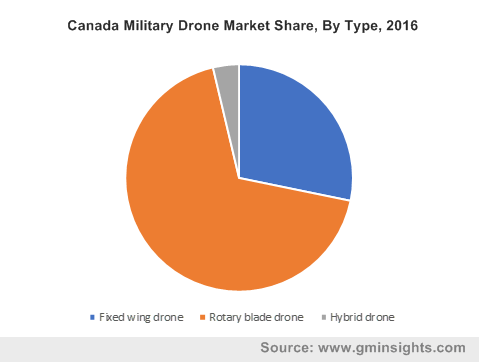A regional outline of military drone market: heavy investments in defense technology developments to boost the industry expansion over 2017-2024
Publisher : Fractovia | Published Date : 2018-04-26Request Sample
The rapid emergence of drone technologies in military & defense operations has been adding momentum to military unmanned aerial vehicle (UAV) market. In the last two decades, the UAV has emerged as one of the biggest revolutions in warfare pertaining to its capability to conduct airstrikes without any human intervention. Currently, it has been observed that defense organizations across myriad geographies, in order to safeguard their personnel, have been inclining more toward UAV technologies during complex military operations. These technologies are used to collect sufficient data from warfare sites very effectively only via surveillance, post which military units can frame action plans to identify a target and improve safety. This change of military tactics has led to many governments recognizing the benefits of drone technology and accordingly investing in the development of UAV technologies for military operations.
U.S. Military Drone Market Share, By Product, 2016

The rise in the usability of advanced technologies such as artificial intelligence and IoT has also had a positive influence on military drone industry outlook. Technology companies have naturally been proactive in this regard and are looking forward to launching innovative drone versions for defense operations with the development of machine learning software. Given that this is an issue of national security, these tech firms have also been collaborating with regional governments for developing smarter drone software systems.
An instance demonstrating the authenticity of the aforesaid statement is that of the partnership between tech giant Google and the U.S. Department of Defense. The two organizations recently inked a lucrative collaboration deal where Google would provide machine learning software to the latter that would help the organization effectively detect objects and study drone footage. The partnership is a classic instance justifying that collaborative deals between government organizations and private entities are certain to bring about a long-lasting impact on military unmanned aerial vehicle industry outlook. While numerous regional governments are already involved in the development of UAVs for defense, the contribution of China and the United States toward military drone market is specifically appreciable, a gist of which is outlined below.
China to enhance its military potential with the launch of smart drones
China is counted among the top regional contributors in military drone market, given its massive production of UAVs and its involvement in innovative drone development. Recently, at the Zhuhai 2016 Airshow, China displayed its surveillance and high-attack drones in addition to giving a glimpse of its futuristic products – stealthy drones to be precise, tentatively titled CH-X. In addition, China is also working on the development of drones which will be capable of flying from aircraft carriers. The nation’s high-flying goals to outmaneuver its rivals including Russia and U.S., with the launch of highly advanced drone technologies, is likely to expedite the regional military UAV market share.
Currently, China has successfully tested vertical take-off and landing (VTOL) unmanned aerial systems on its warships. These VTOL drones, i.e., unmanned helicopters can apparently be used for anti-submarine missions and reconnaissance. Furthermore, in 2017, China crossed a remarkable milestone when it accomplished the mobilization of the largest swarm of drones ever. Indeed, the highly autonomous capability of swarms can be used for achieving numerous on-field benefits in the future. Endowed with a slew of such highly productive triumphs, China has indeed proved itself superior in military UAV market as opposed to other economies. As per estimates in fact, China presently accounts for nearly 50% of the APAC military UAV industry share and is predicted to emerge as a pivotal revenue ground in the years ahead.
Increasing investments in drone technologies to propel U.S. military UAV market share
The U.S. Department of Defense has constantly been involved in myriad drone technology research projects in order to race ahead of its arch rivals, China and Russia. Merely a few days ago, the U.S. Air Force awarded a contract of USD 928 million to Lockheed Martin Corp. to develop hypersonic strike weapons in order to stand tall amidst its industry contenders. Additionally, the U.S. army has also been putting in their efforts to conduct numerous tech-supported demonstrations for launching futuristic unmanned aircraft systems (UAS).
Improved UASs are known to categorize data in terms of weather conditions, GPS coordinates, mission data, and video. With such advancements in information processing, military personnel would be able to control and monitor missions very effectively by taking time-sensitive decisions. Right from conducting airstrikes to disabling bombs, these systems are worth their weight in gold. As companies based across the United States strive to provide software upgrades to existing military drones and launch advanced, tech-embedded UAVs, U.S. unmanned aerial vehicle industry size is likely to observe an incline.
The forthcoming years will witness military communities across the globe increasing their dependence on machines for defense and security purposes. This would call for substantial funding by various regional governments in drone development and advanced technologies. Most of the geographies across the globe have already increased their annual defense budget for deploying more unmanned drones for surveillance and safety purpose. This would perpetually augment the revenue graph of military drone market over the ensuing years. As per reliable estimates, military unmanned aerial vehicle (UAV) industry size will register an annual growth rate of about 12% over 2017-2024.